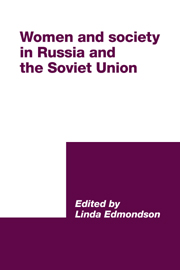Book contents
- Frontmatter
- Contents
- Notes on contributors
- Preface
- Introduction
- 1 ‘Better halves’? Representations of women in Russian urban popular entertainments, 1870-1910
- 2 The Silver Age: highpoint for women?
- 3 Women pharmacists in Russia before World War I: women's emancipation, feminism, professionalization, nationalism and class conflict
- 4 Women's rights, civil rights and the debate over citizenship in the 1905 Revolution
- 5 Laying the foundations of democracy in Russia: E. D. Kuskova's contribution, February–October 1917
- 6 Mariia L. Bochkareva and the Russian amazons of 1917
- 7 Russian women writers: an overview. Post-revolutionary dispersion and adjustment
- 8 Victim or villain? Prostitution in post-revolutionary Russia
- 9 Young women and perestroika
- 10 Glasnost and the woman question
- Index
3 - Women pharmacists in Russia before World War I: women's emancipation, feminism, professionalization, nationalism and class conflict
Published online by Cambridge University Press: 22 October 2009
- Frontmatter
- Contents
- Notes on contributors
- Preface
- Introduction
- 1 ‘Better halves’? Representations of women in Russian urban popular entertainments, 1870-1910
- 2 The Silver Age: highpoint for women?
- 3 Women pharmacists in Russia before World War I: women's emancipation, feminism, professionalization, nationalism and class conflict
- 4 Women's rights, civil rights and the debate over citizenship in the 1905 Revolution
- 5 Laying the foundations of democracy in Russia: E. D. Kuskova's contribution, February–October 1917
- 6 Mariia L. Bochkareva and the Russian amazons of 1917
- 7 Russian women writers: an overview. Post-revolutionary dispersion and adjustment
- 8 Victim or villain? Prostitution in post-revolutionary Russia
- 9 Young women and perestroika
- 10 Glasnost and the woman question
- Index
Summary
The number of women pharmacists in nineteenth- and early twentieth-century Russia was minuscule – well under 1,000 by the First World War in a pharmacist population of some 10,000 and a general population of over 125,000,000. Nevertheless, an examination of women pharmacists in pre-Soviet Russia provides interesting information on significant socio-economic and political trends and developments and, additionally, serves as an indicator of the strength and vitality of female emancipation in the Russia of that era. Women pharmacists reflected the socio-economic, national and political diversity of late imperial Russia. Some became successful entrepreneurs, members of the pharmaceutical aristocracy, and worked for pharmaceutical professionalization. Others identified with the proletariat, becoming labour organizers, participants in strikes and Marxists of Menshevik hue. Still others withdrew to the sanctuary of the research laboratory. To a greater degree than their male colleagues, women pharmacists represented non-Russian minorities – Jews, Poles and Germans – but they exhibited an ‘imperial’ outlook at least until mid-First World War. All women pharmacists strove for their own emancipation and some extended a helping hand to their sisters. But their commitment to feminism and equal rights for women in general was subordinate to securing their own personal advancement and to their various political ideologies.
Women had been allowed to practise as pharmacists (aptekari) in women's medical facilities from 1871. They had been able also to own pharmacies. In 1901, of 3,518 pharmacies in the Russian Empire, wives of pharmacists owned 110 in European Russia and 20 in Asiatic Russia.
- Type
- Chapter
- Information
- Women and Society in Russia and the Soviet Union , pp. 48 - 76Publisher: Cambridge University PressPrint publication year: 1992

